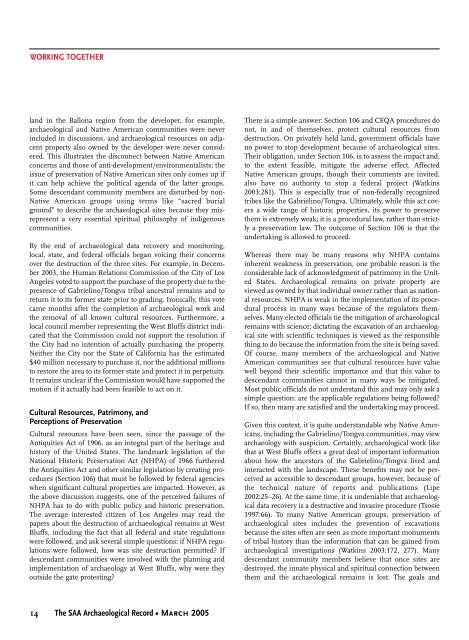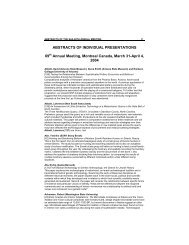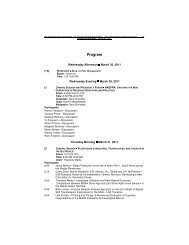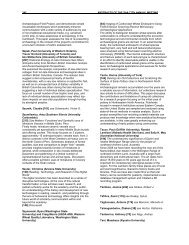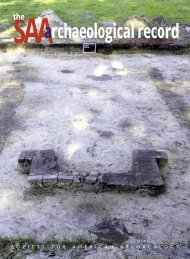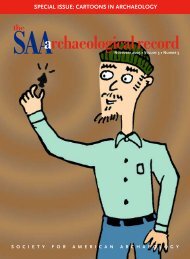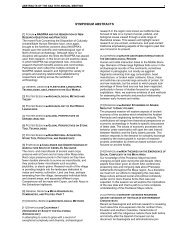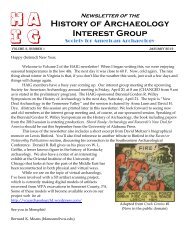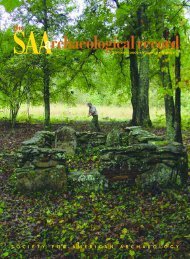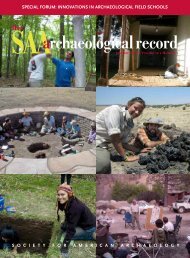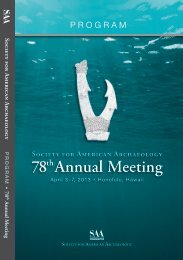The Public Meaning of Archaeological Heritage - Society for ...
The Public Meaning of Archaeological Heritage - Society for ...
The Public Meaning of Archaeological Heritage - Society for ...
Create successful ePaper yourself
Turn your PDF publications into a flip-book with our unique Google optimized e-Paper software.
WORKING TOGETHER<br />
land in the Ballona region from the developer, <strong>for</strong> example,<br />
archaeological and Native American communities were never<br />
included in discussions, and archaeological resources on adjacent<br />
property also owned by the developer were never considered.<br />
This illustrates the disconnect between Native American<br />
concerns and those <strong>of</strong> anti-development/environmentalists; the<br />
issue <strong>of</strong> preservation <strong>of</strong> Native American sites only comes up if<br />
it can help achieve the political agenda <strong>of</strong> the latter groups.<br />
Some descendant community members are disturbed by non-<br />
Native American groups using terms like “sacred burial<br />
ground” to describe the archaeological sites because they misrepresent<br />
a very essential spiritual philosophy <strong>of</strong> indigenous<br />
communities.<br />
By the end <strong>of</strong> archaeological data recovery and monitoring,<br />
local, state, and federal <strong>of</strong>ficials began voicing their concerns<br />
over the destruction <strong>of</strong> the three sites. For example, in December<br />
2003, the Human Relations Commission <strong>of</strong> the City <strong>of</strong> Los<br />
Angeles voted to support the purchase <strong>of</strong> the property due to the<br />
presence <strong>of</strong> Gabrielino/Tongva tribal ancestral remains and to<br />
return it to its <strong>for</strong>mer state prior to grading. Ironically, this vote<br />
came months after the completion <strong>of</strong> archaeological work and<br />
the removal <strong>of</strong> all known cultural resources. Furthermore, a<br />
local council member representing the West Bluffs district indicated<br />
that the Commission could not support the resolution if<br />
the City had no intention <strong>of</strong> actually purchasing the property.<br />
Neither the City nor the State <strong>of</strong> Cali<strong>for</strong>nia has the estimated<br />
$40 million necessary to purchase it, nor the additional millions<br />
to restore the area to its <strong>for</strong>mer state and protect it in perpetuity.<br />
It remains unclear if the Commission would have supported the<br />
motion if it actually had been feasible to act on it.<br />
Cultural Resources, Patrimony, and<br />
Perceptions <strong>of</strong> Preservation<br />
Cultural resources have been seen, since the passage <strong>of</strong> the<br />
Antiquities Act <strong>of</strong> 1906, as an integral part <strong>of</strong> the heritage and<br />
history <strong>of</strong> the United States. <strong>The</strong> landmark legislation <strong>of</strong> the<br />
National Historic Preservation Act (NHPA) <strong>of</strong> 1966 furthered<br />
the Antiquities Act and other similar legislation by creating procedures<br />
(Section 106) that must be followed by federal agencies<br />
when significant cultural properties are impacted. However, as<br />
the above discussion suggests, one <strong>of</strong> the perceived failures <strong>of</strong><br />
NHPA has to do with public policy and historic preservation.<br />
<strong>The</strong> average interested citizen <strong>of</strong> Los Angeles may read the<br />
papers about the destruction <strong>of</strong> archaeological remains at West<br />
Bluffs, including the fact that all federal and state regulations<br />
were followed, and ask several simple questions: if NHPA regulations<br />
were followed, how was site destruction permitted? If<br />
descendant communities were involved with the planning and<br />
implementation <strong>of</strong> archaeology at West Bluffs, why were they<br />
outside the gate protesting?<br />
<strong>The</strong>re is a simple answer: Section 106 and CEQA procedures do<br />
not, in and <strong>of</strong> themselves, protect cultural resources from<br />
destruction. On privately held land, government <strong>of</strong>ficials have<br />
no power to stop development because <strong>of</strong> archaeological sites.<br />
<strong>The</strong>ir obligation, under Section 106, is to assess the impact and,<br />
to the extent feasible, mitigate the adverse effect. Affected<br />
Native American groups, though their comments are invited,<br />
also have no authority to stop a federal project (Watkins<br />
2003:281). This is especially true <strong>of</strong> non-federally recognized<br />
tribes like the Gabrielino/Tongva. Ultimately, while this act covers<br />
a wide range <strong>of</strong> historic properties, its power to preserve<br />
them is extremely weak; it is a procedural law, rather than strictly<br />
a preservation law. <strong>The</strong> outcome <strong>of</strong> Section 106 is that the<br />
undertaking is allowed to proceed.<br />
Whereas there may be many reasons why NHPA contains<br />
inherent weakness in preservation, one probable reason is the<br />
considerable lack <strong>of</strong> acknowledgment <strong>of</strong> patrimony in the United<br />
States. <strong>Archaeological</strong> remains on private property are<br />
viewed as owned by that individual owner rather than as national<br />
resources. NHPA is weak in the implementation <strong>of</strong> its procedural<br />
process in many ways because <strong>of</strong> the regulators themselves.<br />
Many elected <strong>of</strong>ficials tie the mitigation <strong>of</strong> archaeological<br />
remains with science; dictating the excavation <strong>of</strong> an archaeological<br />
site with scientific techniques is viewed as the responsible<br />
thing to do because the in<strong>for</strong>mation from the site is being saved.<br />
Of course, many members <strong>of</strong> the archaeological and Native<br />
American communities see that cultural resources have value<br />
well beyond their scientific importance and that this value to<br />
descendant communities cannot in many ways be mitigated.<br />
Most public <strong>of</strong>ficials do not understand this and may only ask a<br />
simple question: are the applicable regulations being followed?<br />
If so, then many are satisfied and the undertaking may proceed.<br />
Given this context, it is quite understandable why Native Americans,<br />
including the Gabrielino/Tongva communities, may view<br />
archaeology with suspicion. Certainly, archaeological work like<br />
that at West Bluffs <strong>of</strong>fers a great deal <strong>of</strong> important in<strong>for</strong>mation<br />
about how the ancestors <strong>of</strong> the Gabrielino/Tongva lived and<br />
interacted with the landscape. <strong>The</strong>se benefits may not be perceived<br />
as accessible to descendant groups, however, because <strong>of</strong><br />
the technical nature <strong>of</strong> reports and publications (Lipe<br />
2002:25–26). At the same time, it is undeniable that archaeological<br />
data recovery is a destructive and invasive procedure (Tsosie<br />
1997:66). To many Native American groups, preservation <strong>of</strong><br />
archaeological sites includes the prevention <strong>of</strong> excavations<br />
because the sites <strong>of</strong>ten are seen as more important monuments<br />
<strong>of</strong> tribal history than the in<strong>for</strong>mation that can be gained from<br />
archaeological investigations (Watkins 2003:172, 277). Many<br />
descendant community members believe that once sites are<br />
destroyed, the innate physical and spiritual connection between<br />
them and the archaeological remains is lost. <strong>The</strong> goals and<br />
14 <strong>The</strong> SAA <strong>Archaeological</strong> Record • March 2005


